Queen's University ECON310: Economic Impact of COVID-19 Essay
VerifiedAdded on 2022/09/17
|6
|2156
|29
Essay
AI Summary
This essay provides a comprehensive analysis of the economic impact of the COVID-19 pandemic, examining its effects through partial and general equilibrium frameworks. It begins by analyzing the impact on the labor market, including rising unemployment and wage fluctuations, and discusses how the pandemic has disrupted supply chains and global sourcing. The essay then explores the broader implications for the global economy, comparing the crisis to the Great Depression and post-World War II scenarios, and highlighting the impact on various economic sectors and international trade. Finally, the essay delves into policy analysis, suggesting fiscal stimulus packages, accommodative monetary policy, and measures to protect the workforce, including unemployment benefits and support for MSMEs. The conclusion emphasizes the long-term consequences of the pandemic and the importance of policy interventions to foster economic recovery and retain employment.
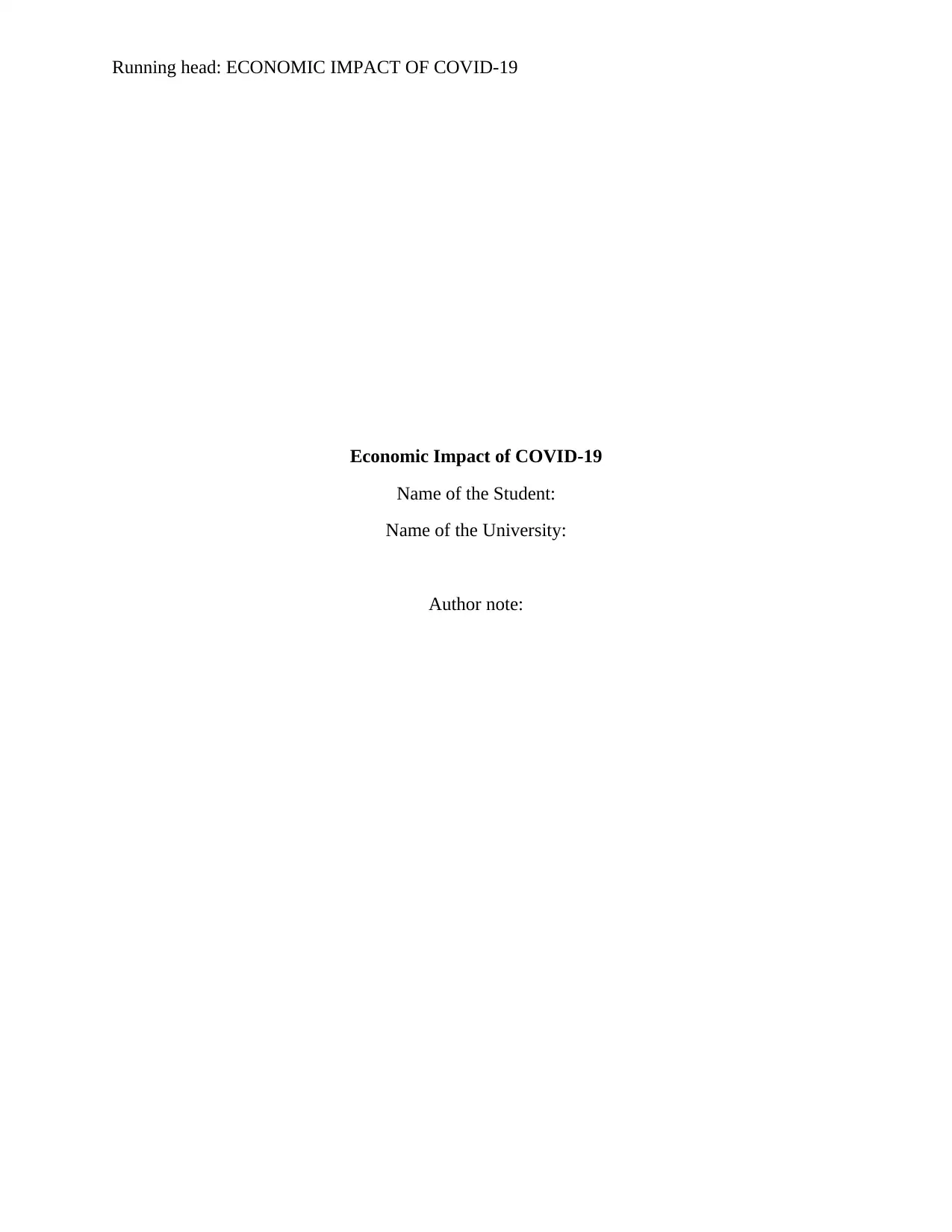
Running head: ECONOMIC IMPACT OF COVID-19
Economic Impact of COVID-19
Name of the Student:
Name of the University:
Author note:
Economic Impact of COVID-19
Name of the Student:
Name of the University:
Author note:
Paraphrase This Document
Need a fresh take? Get an instant paraphrase of this document with our AI Paraphraser
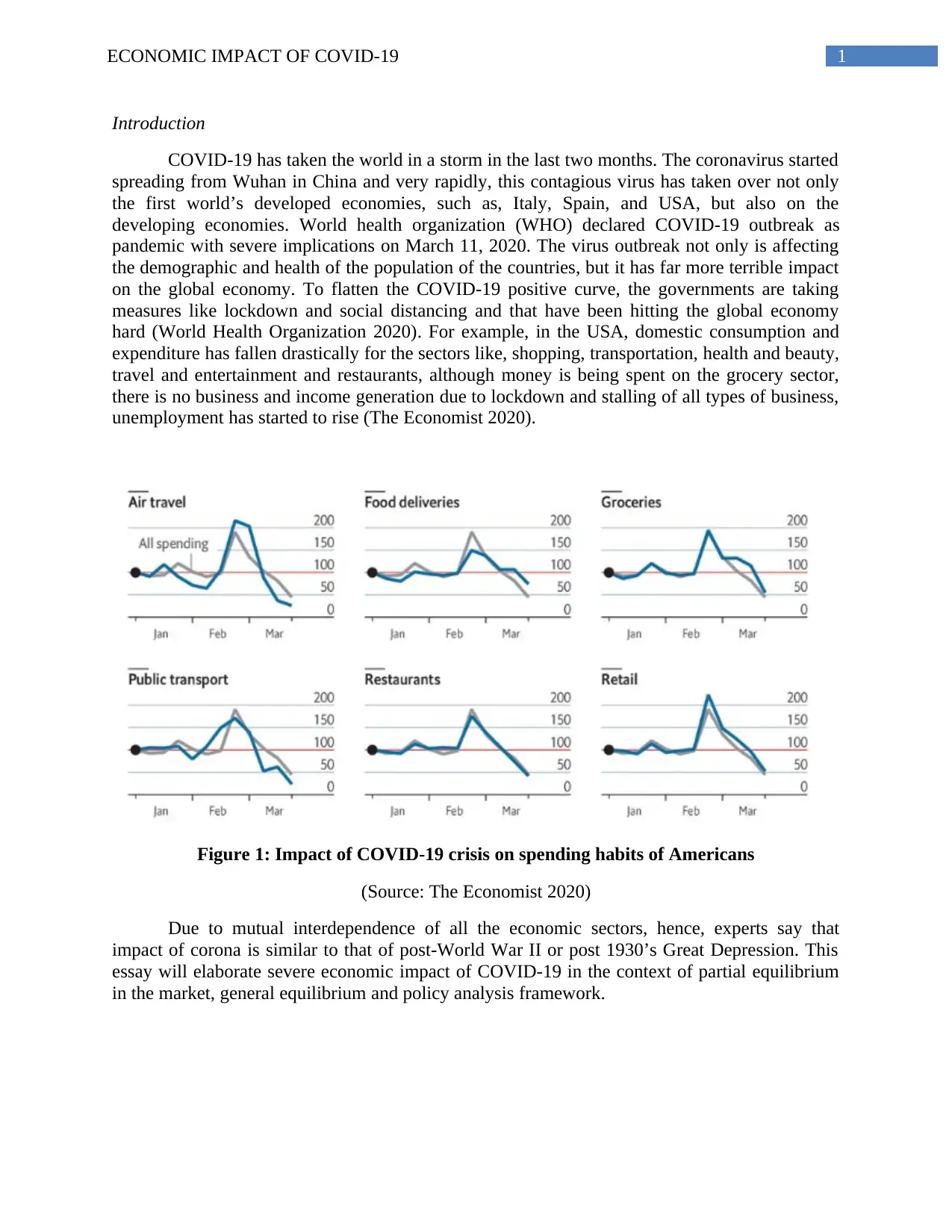
1ECONOMIC IMPACT OF COVID-19
Introduction
COVID-19 has taken the world in a storm in the last two months. The coronavirus started
spreading from Wuhan in China and very rapidly, this contagious virus has taken over not only
the first world’s developed economies, such as, Italy, Spain, and USA, but also on the
developing economies. World health organization (WHO) declared COVID-19 outbreak as
pandemic with severe implications on March 11, 2020. The virus outbreak not only is affecting
the demographic and health of the population of the countries, but it has far more terrible impact
on the global economy. To flatten the COVID-19 positive curve, the governments are taking
measures like lockdown and social distancing and that have been hitting the global economy
hard (World Health Organization 2020). For example, in the USA, domestic consumption and
expenditure has fallen drastically for the sectors like, shopping, transportation, health and beauty,
travel and entertainment and restaurants, although money is being spent on the grocery sector,
there is no business and income generation due to lockdown and stalling of all types of business,
unemployment has started to rise (The Economist 2020).
Figure 1: Impact of COVID-19 crisis on spending habits of Americans
(Source: The Economist 2020)
Due to mutual interdependence of all the economic sectors, hence, experts say that
impact of corona is similar to that of post-World War II or post 1930’s Great Depression. This
essay will elaborate severe economic impact of COVID-19 in the context of partial equilibrium
in the market, general equilibrium and policy analysis framework.
Introduction
COVID-19 has taken the world in a storm in the last two months. The coronavirus started
spreading from Wuhan in China and very rapidly, this contagious virus has taken over not only
the first world’s developed economies, such as, Italy, Spain, and USA, but also on the
developing economies. World health organization (WHO) declared COVID-19 outbreak as
pandemic with severe implications on March 11, 2020. The virus outbreak not only is affecting
the demographic and health of the population of the countries, but it has far more terrible impact
on the global economy. To flatten the COVID-19 positive curve, the governments are taking
measures like lockdown and social distancing and that have been hitting the global economy
hard (World Health Organization 2020). For example, in the USA, domestic consumption and
expenditure has fallen drastically for the sectors like, shopping, transportation, health and beauty,
travel and entertainment and restaurants, although money is being spent on the grocery sector,
there is no business and income generation due to lockdown and stalling of all types of business,
unemployment has started to rise (The Economist 2020).
Figure 1: Impact of COVID-19 crisis on spending habits of Americans
(Source: The Economist 2020)
Due to mutual interdependence of all the economic sectors, hence, experts say that
impact of corona is similar to that of post-World War II or post 1930’s Great Depression. This
essay will elaborate severe economic impact of COVID-19 in the context of partial equilibrium
in the market, general equilibrium and policy analysis framework.
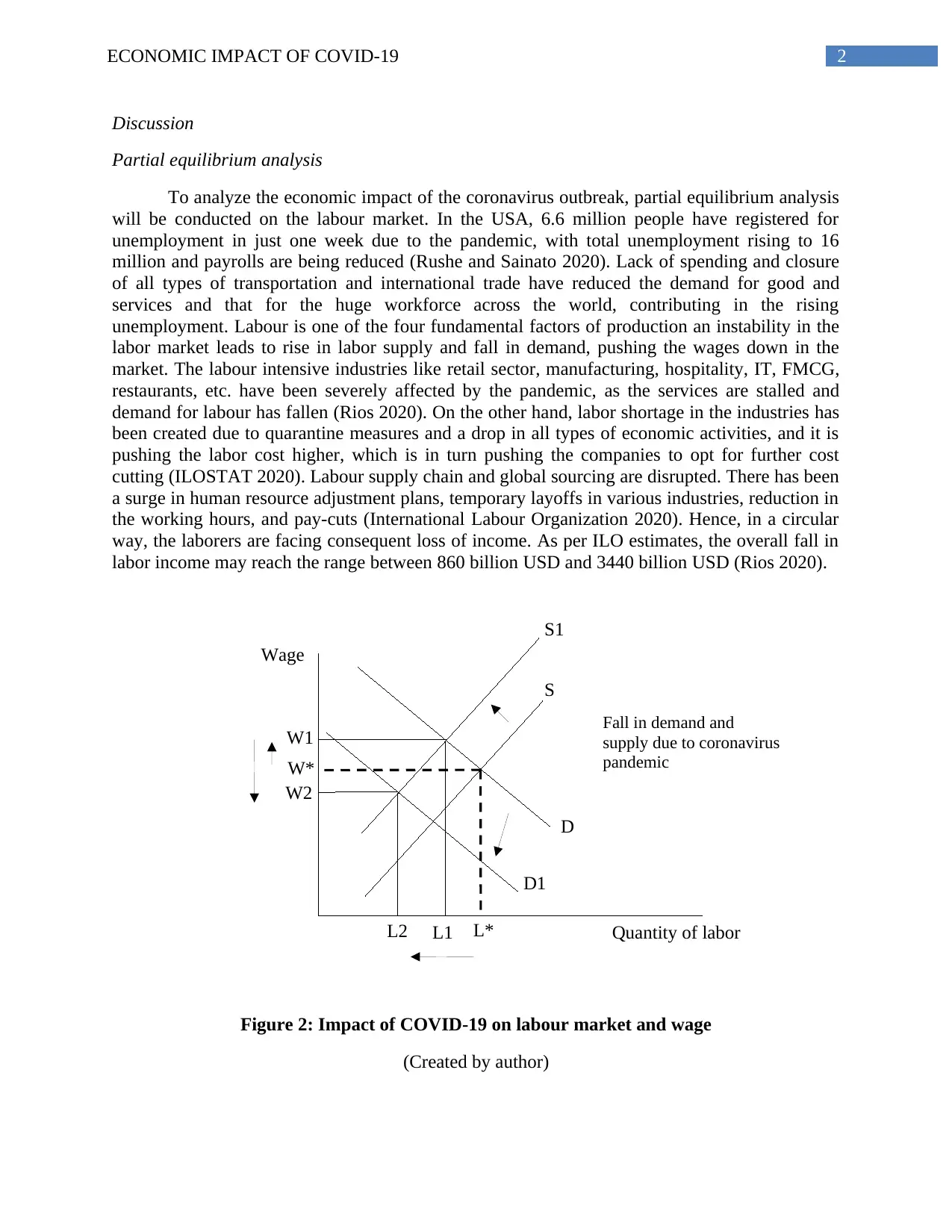
2ECONOMIC IMPACT OF COVID-19
S
S1
D
D1
W*
W1
W2
L*L1L2 Quantity of labor
Wage
Fall in demand and
supply due to coronavirus
pandemic
Discussion
Partial equilibrium analysis
To analyze the economic impact of the coronavirus outbreak, partial equilibrium analysis
will be conducted on the labour market. In the USA, 6.6 million people have registered for
unemployment in just one week due to the pandemic, with total unemployment rising to 16
million and payrolls are being reduced (Rushe and Sainato 2020). Lack of spending and closure
of all types of transportation and international trade have reduced the demand for good and
services and that for the huge workforce across the world, contributing in the rising
unemployment. Labour is one of the four fundamental factors of production an instability in the
labor market leads to rise in labor supply and fall in demand, pushing the wages down in the
market. The labour intensive industries like retail sector, manufacturing, hospitality, IT, FMCG,
restaurants, etc. have been severely affected by the pandemic, as the services are stalled and
demand for labour has fallen (Rios 2020). On the other hand, labor shortage in the industries has
been created due to quarantine measures and a drop in all types of economic activities, and it is
pushing the labor cost higher, which is in turn pushing the companies to opt for further cost
cutting (ILOSTAT 2020). Labour supply chain and global sourcing are disrupted. There has been
a surge in human resource adjustment plans, temporary layoffs in various industries, reduction in
the working hours, and pay-cuts (International Labour Organization 2020). Hence, in a circular
way, the laborers are facing consequent loss of income. As per ILO estimates, the overall fall in
labor income may reach the range between 860 billion USD and 3440 billion USD (Rios 2020).
Figure 2: Impact of COVID-19 on labour market and wage
(Created by author)
S
S1
D
D1
W*
W1
W2
L*L1L2 Quantity of labor
Wage
Fall in demand and
supply due to coronavirus
pandemic
Discussion
Partial equilibrium analysis
To analyze the economic impact of the coronavirus outbreak, partial equilibrium analysis
will be conducted on the labour market. In the USA, 6.6 million people have registered for
unemployment in just one week due to the pandemic, with total unemployment rising to 16
million and payrolls are being reduced (Rushe and Sainato 2020). Lack of spending and closure
of all types of transportation and international trade have reduced the demand for good and
services and that for the huge workforce across the world, contributing in the rising
unemployment. Labour is one of the four fundamental factors of production an instability in the
labor market leads to rise in labor supply and fall in demand, pushing the wages down in the
market. The labour intensive industries like retail sector, manufacturing, hospitality, IT, FMCG,
restaurants, etc. have been severely affected by the pandemic, as the services are stalled and
demand for labour has fallen (Rios 2020). On the other hand, labor shortage in the industries has
been created due to quarantine measures and a drop in all types of economic activities, and it is
pushing the labor cost higher, which is in turn pushing the companies to opt for further cost
cutting (ILOSTAT 2020). Labour supply chain and global sourcing are disrupted. There has been
a surge in human resource adjustment plans, temporary layoffs in various industries, reduction in
the working hours, and pay-cuts (International Labour Organization 2020). Hence, in a circular
way, the laborers are facing consequent loss of income. As per ILO estimates, the overall fall in
labor income may reach the range between 860 billion USD and 3440 billion USD (Rios 2020).
Figure 2: Impact of COVID-19 on labour market and wage
(Created by author)
⊘ This is a preview!⊘
Do you want full access?
Subscribe today to unlock all pages.

Trusted by 1+ million students worldwide
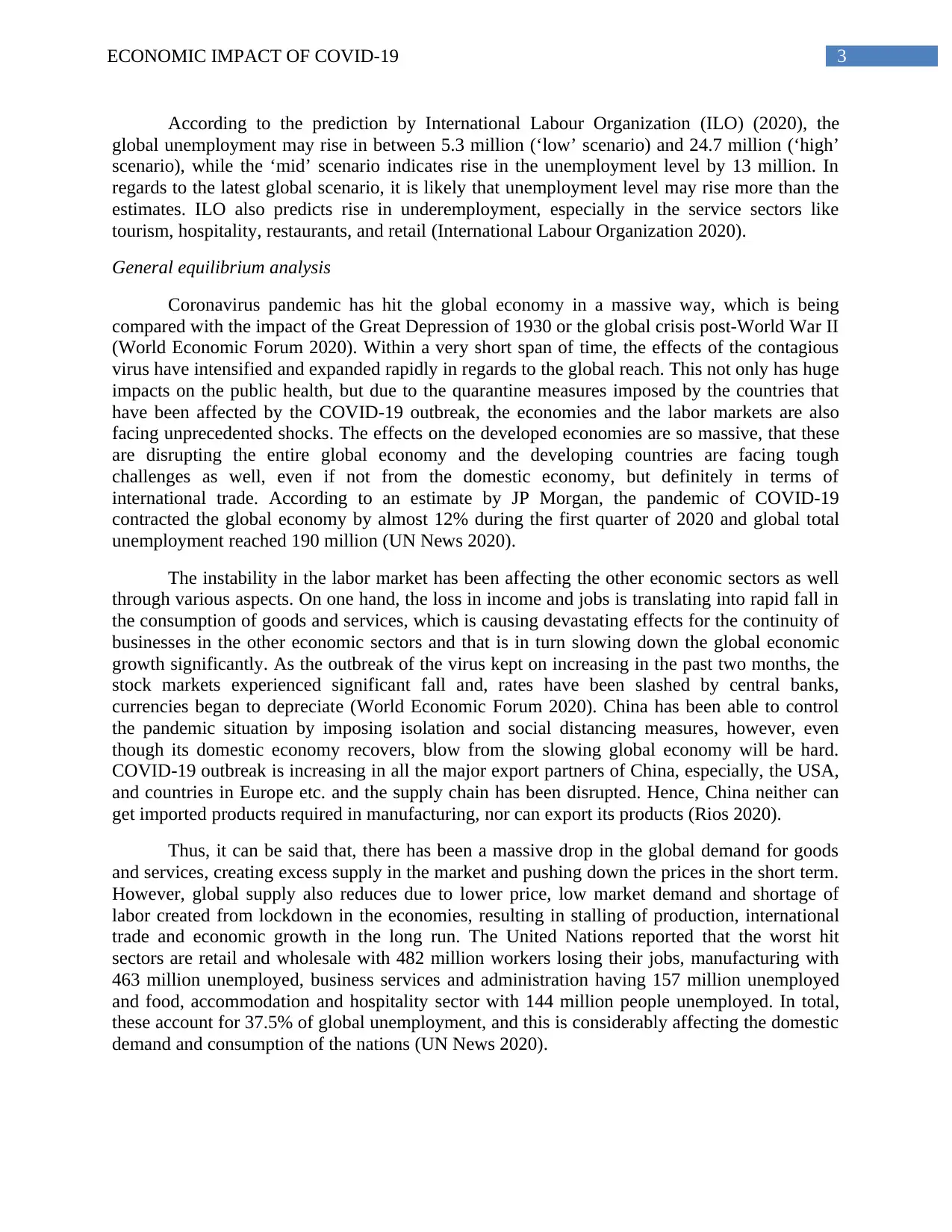
3ECONOMIC IMPACT OF COVID-19
According to the prediction by International Labour Organization (ILO) (2020), the
global unemployment may rise in between 5.3 million (‘low’ scenario) and 24.7 million (‘high’
scenario), while the ‘mid’ scenario indicates rise in the unemployment level by 13 million. In
regards to the latest global scenario, it is likely that unemployment level may rise more than the
estimates. ILO also predicts rise in underemployment, especially in the service sectors like
tourism, hospitality, restaurants, and retail (International Labour Organization 2020).
General equilibrium analysis
Coronavirus pandemic has hit the global economy in a massive way, which is being
compared with the impact of the Great Depression of 1930 or the global crisis post-World War II
(World Economic Forum 2020). Within a very short span of time, the effects of the contagious
virus have intensified and expanded rapidly in regards to the global reach. This not only has huge
impacts on the public health, but due to the quarantine measures imposed by the countries that
have been affected by the COVID-19 outbreak, the economies and the labor markets are also
facing unprecedented shocks. The effects on the developed economies are so massive, that these
are disrupting the entire global economy and the developing countries are facing tough
challenges as well, even if not from the domestic economy, but definitely in terms of
international trade. According to an estimate by JP Morgan, the pandemic of COVID-19
contracted the global economy by almost 12% during the first quarter of 2020 and global total
unemployment reached 190 million (UN News 2020).
The instability in the labor market has been affecting the other economic sectors as well
through various aspects. On one hand, the loss in income and jobs is translating into rapid fall in
the consumption of goods and services, which is causing devastating effects for the continuity of
businesses in the other economic sectors and that is in turn slowing down the global economic
growth significantly. As the outbreak of the virus kept on increasing in the past two months, the
stock markets experienced significant fall and, rates have been slashed by central banks,
currencies began to depreciate (World Economic Forum 2020). China has been able to control
the pandemic situation by imposing isolation and social distancing measures, however, even
though its domestic economy recovers, blow from the slowing global economy will be hard.
COVID-19 outbreak is increasing in all the major export partners of China, especially, the USA,
and countries in Europe etc. and the supply chain has been disrupted. Hence, China neither can
get imported products required in manufacturing, nor can export its products (Rios 2020).
Thus, it can be said that, there has been a massive drop in the global demand for goods
and services, creating excess supply in the market and pushing down the prices in the short term.
However, global supply also reduces due to lower price, low market demand and shortage of
labor created from lockdown in the economies, resulting in stalling of production, international
trade and economic growth in the long run. The United Nations reported that the worst hit
sectors are retail and wholesale with 482 million workers losing their jobs, manufacturing with
463 million unemployed, business services and administration having 157 million unemployed
and food, accommodation and hospitality sector with 144 million people unemployed. In total,
these account for 37.5% of global unemployment, and this is considerably affecting the domestic
demand and consumption of the nations (UN News 2020).
According to the prediction by International Labour Organization (ILO) (2020), the
global unemployment may rise in between 5.3 million (‘low’ scenario) and 24.7 million (‘high’
scenario), while the ‘mid’ scenario indicates rise in the unemployment level by 13 million. In
regards to the latest global scenario, it is likely that unemployment level may rise more than the
estimates. ILO also predicts rise in underemployment, especially in the service sectors like
tourism, hospitality, restaurants, and retail (International Labour Organization 2020).
General equilibrium analysis
Coronavirus pandemic has hit the global economy in a massive way, which is being
compared with the impact of the Great Depression of 1930 or the global crisis post-World War II
(World Economic Forum 2020). Within a very short span of time, the effects of the contagious
virus have intensified and expanded rapidly in regards to the global reach. This not only has huge
impacts on the public health, but due to the quarantine measures imposed by the countries that
have been affected by the COVID-19 outbreak, the economies and the labor markets are also
facing unprecedented shocks. The effects on the developed economies are so massive, that these
are disrupting the entire global economy and the developing countries are facing tough
challenges as well, even if not from the domestic economy, but definitely in terms of
international trade. According to an estimate by JP Morgan, the pandemic of COVID-19
contracted the global economy by almost 12% during the first quarter of 2020 and global total
unemployment reached 190 million (UN News 2020).
The instability in the labor market has been affecting the other economic sectors as well
through various aspects. On one hand, the loss in income and jobs is translating into rapid fall in
the consumption of goods and services, which is causing devastating effects for the continuity of
businesses in the other economic sectors and that is in turn slowing down the global economic
growth significantly. As the outbreak of the virus kept on increasing in the past two months, the
stock markets experienced significant fall and, rates have been slashed by central banks,
currencies began to depreciate (World Economic Forum 2020). China has been able to control
the pandemic situation by imposing isolation and social distancing measures, however, even
though its domestic economy recovers, blow from the slowing global economy will be hard.
COVID-19 outbreak is increasing in all the major export partners of China, especially, the USA,
and countries in Europe etc. and the supply chain has been disrupted. Hence, China neither can
get imported products required in manufacturing, nor can export its products (Rios 2020).
Thus, it can be said that, there has been a massive drop in the global demand for goods
and services, creating excess supply in the market and pushing down the prices in the short term.
However, global supply also reduces due to lower price, low market demand and shortage of
labor created from lockdown in the economies, resulting in stalling of production, international
trade and economic growth in the long run. The United Nations reported that the worst hit
sectors are retail and wholesale with 482 million workers losing their jobs, manufacturing with
463 million unemployed, business services and administration having 157 million unemployed
and food, accommodation and hospitality sector with 144 million people unemployed. In total,
these account for 37.5% of global unemployment, and this is considerably affecting the domestic
demand and consumption of the nations (UN News 2020).
Paraphrase This Document
Need a fresh take? Get an instant paraphrase of this document with our AI Paraphraser
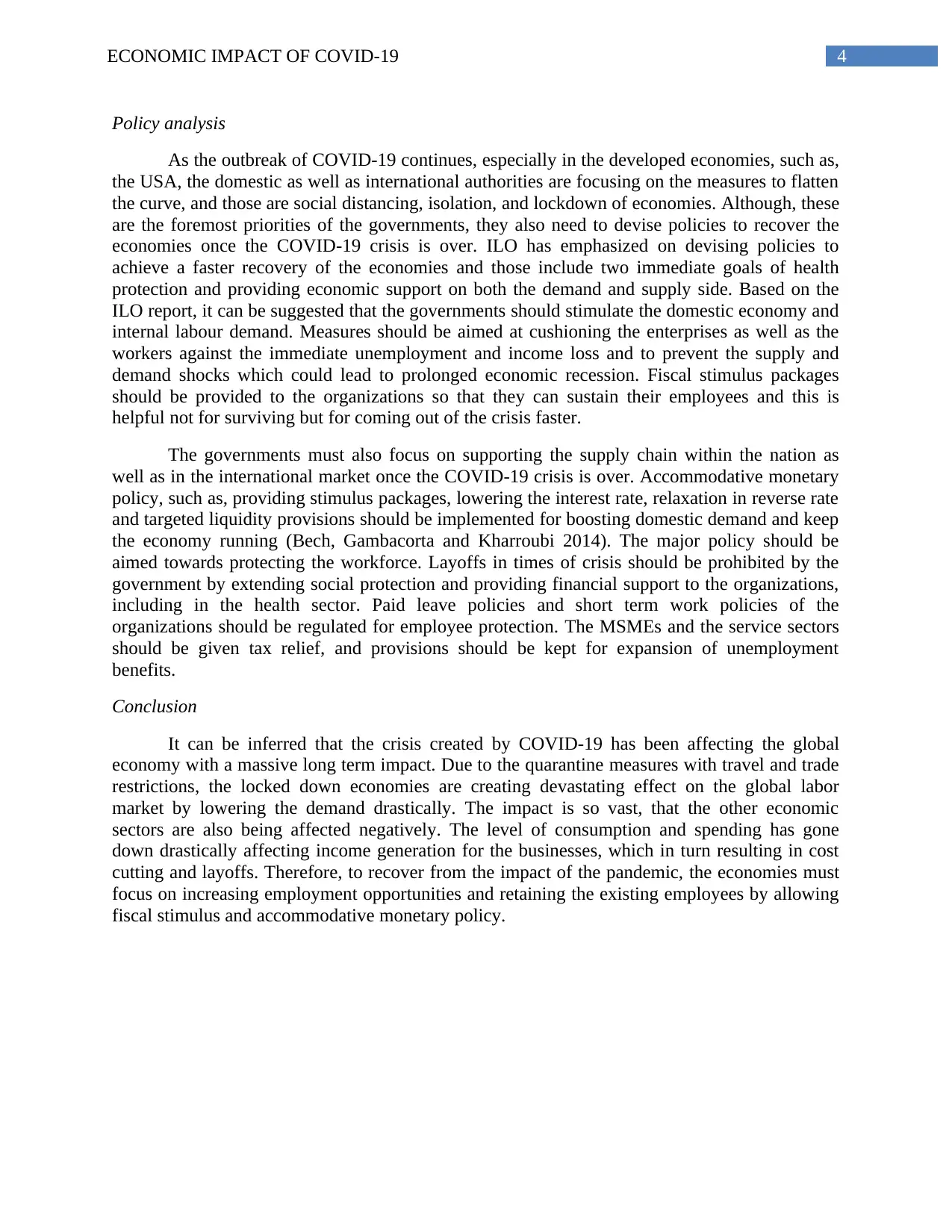
4ECONOMIC IMPACT OF COVID-19
Policy analysis
As the outbreak of COVID-19 continues, especially in the developed economies, such as,
the USA, the domestic as well as international authorities are focusing on the measures to flatten
the curve, and those are social distancing, isolation, and lockdown of economies. Although, these
are the foremost priorities of the governments, they also need to devise policies to recover the
economies once the COVID-19 crisis is over. ILO has emphasized on devising policies to
achieve a faster recovery of the economies and those include two immediate goals of health
protection and providing economic support on both the demand and supply side. Based on the
ILO report, it can be suggested that the governments should stimulate the domestic economy and
internal labour demand. Measures should be aimed at cushioning the enterprises as well as the
workers against the immediate unemployment and income loss and to prevent the supply and
demand shocks which could lead to prolonged economic recession. Fiscal stimulus packages
should be provided to the organizations so that they can sustain their employees and this is
helpful not for surviving but for coming out of the crisis faster.
The governments must also focus on supporting the supply chain within the nation as
well as in the international market once the COVID-19 crisis is over. Accommodative monetary
policy, such as, providing stimulus packages, lowering the interest rate, relaxation in reverse rate
and targeted liquidity provisions should be implemented for boosting domestic demand and keep
the economy running (Bech, Gambacorta and Kharroubi 2014). The major policy should be
aimed towards protecting the workforce. Layoffs in times of crisis should be prohibited by the
government by extending social protection and providing financial support to the organizations,
including in the health sector. Paid leave policies and short term work policies of the
organizations should be regulated for employee protection. The MSMEs and the service sectors
should be given tax relief, and provisions should be kept for expansion of unemployment
benefits.
Conclusion
It can be inferred that the crisis created by COVID-19 has been affecting the global
economy with a massive long term impact. Due to the quarantine measures with travel and trade
restrictions, the locked down economies are creating devastating effect on the global labor
market by lowering the demand drastically. The impact is so vast, that the other economic
sectors are also being affected negatively. The level of consumption and spending has gone
down drastically affecting income generation for the businesses, which in turn resulting in cost
cutting and layoffs. Therefore, to recover from the impact of the pandemic, the economies must
focus on increasing employment opportunities and retaining the existing employees by allowing
fiscal stimulus and accommodative monetary policy.
Policy analysis
As the outbreak of COVID-19 continues, especially in the developed economies, such as,
the USA, the domestic as well as international authorities are focusing on the measures to flatten
the curve, and those are social distancing, isolation, and lockdown of economies. Although, these
are the foremost priorities of the governments, they also need to devise policies to recover the
economies once the COVID-19 crisis is over. ILO has emphasized on devising policies to
achieve a faster recovery of the economies and those include two immediate goals of health
protection and providing economic support on both the demand and supply side. Based on the
ILO report, it can be suggested that the governments should stimulate the domestic economy and
internal labour demand. Measures should be aimed at cushioning the enterprises as well as the
workers against the immediate unemployment and income loss and to prevent the supply and
demand shocks which could lead to prolonged economic recession. Fiscal stimulus packages
should be provided to the organizations so that they can sustain their employees and this is
helpful not for surviving but for coming out of the crisis faster.
The governments must also focus on supporting the supply chain within the nation as
well as in the international market once the COVID-19 crisis is over. Accommodative monetary
policy, such as, providing stimulus packages, lowering the interest rate, relaxation in reverse rate
and targeted liquidity provisions should be implemented for boosting domestic demand and keep
the economy running (Bech, Gambacorta and Kharroubi 2014). The major policy should be
aimed towards protecting the workforce. Layoffs in times of crisis should be prohibited by the
government by extending social protection and providing financial support to the organizations,
including in the health sector. Paid leave policies and short term work policies of the
organizations should be regulated for employee protection. The MSMEs and the service sectors
should be given tax relief, and provisions should be kept for expansion of unemployment
benefits.
Conclusion
It can be inferred that the crisis created by COVID-19 has been affecting the global
economy with a massive long term impact. Due to the quarantine measures with travel and trade
restrictions, the locked down economies are creating devastating effect on the global labor
market by lowering the demand drastically. The impact is so vast, that the other economic
sectors are also being affected negatively. The level of consumption and spending has gone
down drastically affecting income generation for the businesses, which in turn resulting in cost
cutting and layoffs. Therefore, to recover from the impact of the pandemic, the economies must
focus on increasing employment opportunities and retaining the existing employees by allowing
fiscal stimulus and accommodative monetary policy.
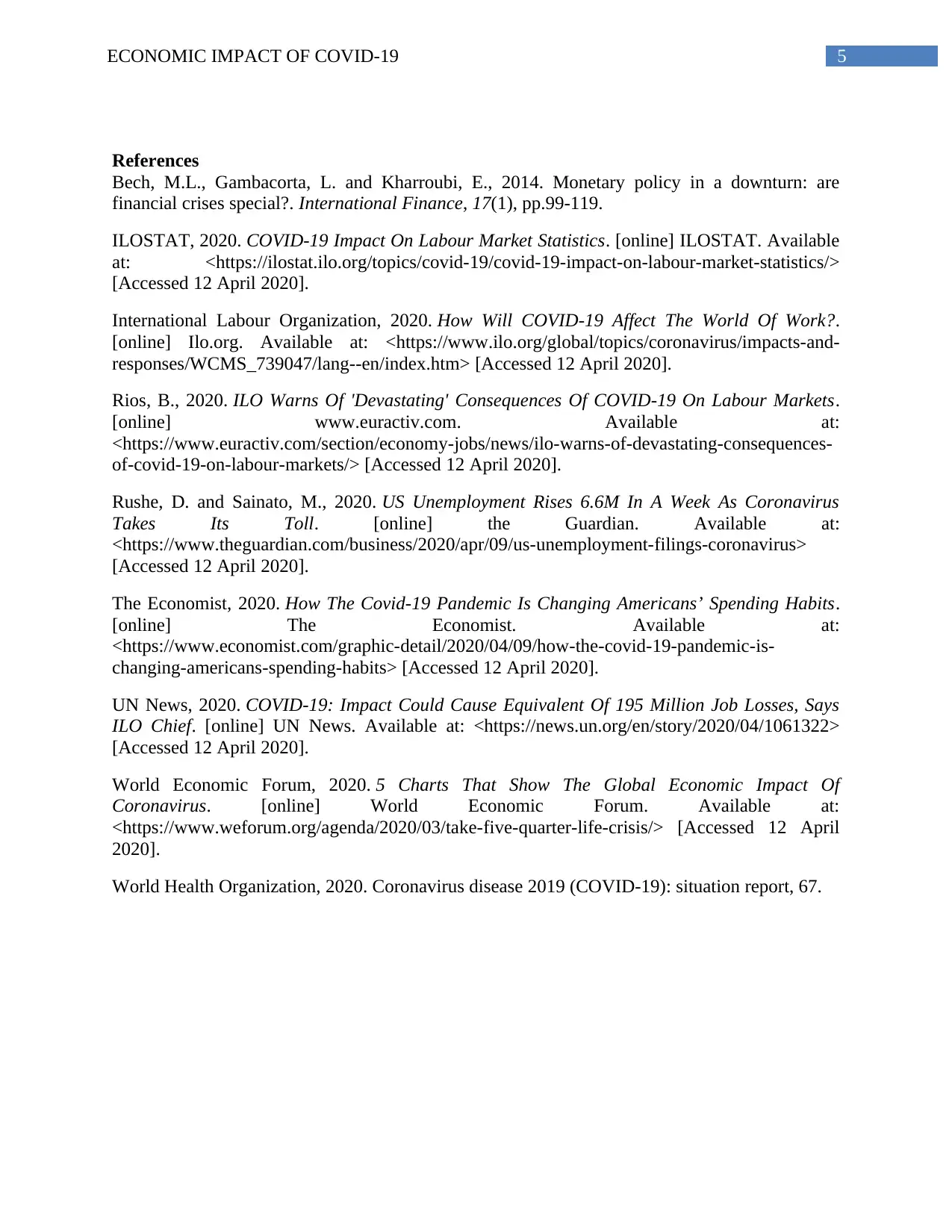
5ECONOMIC IMPACT OF COVID-19
References
Bech, M.L., Gambacorta, L. and Kharroubi, E., 2014. Monetary policy in a downturn: are
financial crises special?. International Finance, 17(1), pp.99-119.
ILOSTAT, 2020. COVID-19 Impact On Labour Market Statistics. [online] ILOSTAT. Available
at: <https://ilostat.ilo.org/topics/covid-19/covid-19-impact-on-labour-market-statistics/>
[Accessed 12 April 2020].
International Labour Organization, 2020. How Will COVID-19 Affect The World Of Work?.
[online] Ilo.org. Available at: <https://www.ilo.org/global/topics/coronavirus/impacts-and-
responses/WCMS_739047/lang--en/index.htm> [Accessed 12 April 2020].
Rios, B., 2020. ILO Warns Of 'Devastating' Consequences Of COVID-19 On Labour Markets.
[online] www.euractiv.com. Available at:
<https://www.euractiv.com/section/economy-jobs/news/ilo-warns-of-devastating-consequences-
of-covid-19-on-labour-markets/> [Accessed 12 April 2020].
Rushe, D. and Sainato, M., 2020. US Unemployment Rises 6.6M In A Week As Coronavirus
Takes Its Toll. [online] the Guardian. Available at:
<https://www.theguardian.com/business/2020/apr/09/us-unemployment-filings-coronavirus>
[Accessed 12 April 2020].
The Economist, 2020. How The Covid-19 Pandemic Is Changing Americans’ Spending Habits.
[online] The Economist. Available at:
<https://www.economist.com/graphic-detail/2020/04/09/how-the-covid-19-pandemic-is-
changing-americans-spending-habits> [Accessed 12 April 2020].
UN News, 2020. COVID-19: Impact Could Cause Equivalent Of 195 Million Job Losses, Says
ILO Chief. [online] UN News. Available at: <https://news.un.org/en/story/2020/04/1061322>
[Accessed 12 April 2020].
World Economic Forum, 2020. 5 Charts That Show The Global Economic Impact Of
Coronavirus. [online] World Economic Forum. Available at:
<https://www.weforum.org/agenda/2020/03/take-five-quarter-life-crisis/> [Accessed 12 April
2020].
World Health Organization, 2020. Coronavirus disease 2019 (COVID-19): situation report, 67.
References
Bech, M.L., Gambacorta, L. and Kharroubi, E., 2014. Monetary policy in a downturn: are
financial crises special?. International Finance, 17(1), pp.99-119.
ILOSTAT, 2020. COVID-19 Impact On Labour Market Statistics. [online] ILOSTAT. Available
at: <https://ilostat.ilo.org/topics/covid-19/covid-19-impact-on-labour-market-statistics/>
[Accessed 12 April 2020].
International Labour Organization, 2020. How Will COVID-19 Affect The World Of Work?.
[online] Ilo.org. Available at: <https://www.ilo.org/global/topics/coronavirus/impacts-and-
responses/WCMS_739047/lang--en/index.htm> [Accessed 12 April 2020].
Rios, B., 2020. ILO Warns Of 'Devastating' Consequences Of COVID-19 On Labour Markets.
[online] www.euractiv.com. Available at:
<https://www.euractiv.com/section/economy-jobs/news/ilo-warns-of-devastating-consequences-
of-covid-19-on-labour-markets/> [Accessed 12 April 2020].
Rushe, D. and Sainato, M., 2020. US Unemployment Rises 6.6M In A Week As Coronavirus
Takes Its Toll. [online] the Guardian. Available at:
<https://www.theguardian.com/business/2020/apr/09/us-unemployment-filings-coronavirus>
[Accessed 12 April 2020].
The Economist, 2020. How The Covid-19 Pandemic Is Changing Americans’ Spending Habits.
[online] The Economist. Available at:
<https://www.economist.com/graphic-detail/2020/04/09/how-the-covid-19-pandemic-is-
changing-americans-spending-habits> [Accessed 12 April 2020].
UN News, 2020. COVID-19: Impact Could Cause Equivalent Of 195 Million Job Losses, Says
ILO Chief. [online] UN News. Available at: <https://news.un.org/en/story/2020/04/1061322>
[Accessed 12 April 2020].
World Economic Forum, 2020. 5 Charts That Show The Global Economic Impact Of
Coronavirus. [online] World Economic Forum. Available at:
<https://www.weforum.org/agenda/2020/03/take-five-quarter-life-crisis/> [Accessed 12 April
2020].
World Health Organization, 2020. Coronavirus disease 2019 (COVID-19): situation report, 67.
⊘ This is a preview!⊘
Do you want full access?
Subscribe today to unlock all pages.

Trusted by 1+ million students worldwide
1 out of 6
Related Documents
Your All-in-One AI-Powered Toolkit for Academic Success.
+13062052269
info@desklib.com
Available 24*7 on WhatsApp / Email
![[object Object]](/_next/static/media/star-bottom.7253800d.svg)
Unlock your academic potential
Copyright © 2020–2026 A2Z Services. All Rights Reserved. Developed and managed by ZUCOL.



